Packaging Alternative Proteins: Hints and Kinks
Some key pointers for those processors interested in competing in the alternative proteins market.

Image courtesy of Getty Images / miniseries
In general, public perception of alternative proteins is one that fosters environmentally friendly product and packaging materials. Consumers feel that in purchasing these products they are doing their part to sustain the environment. For example, while I’ve been a long-time user of alternative dairy drinks and an occasional purchaser of alternative meat products, I’d like to believe that the production and packaging processes to make what I purchased are environmentally friendly. But I’ve also wondered what specific problems arise in the production and packaging of these products compared to conventional protein products.

About Jay Siers
Jay Siers has more than 35 years’ experience in case ready packaging and food handling equipment. Between positions at Harpak-ULMNA, Siers worked for FPEC Corporation as a North American sales manager. He previously worked for Harpak Inc. as a field sales manager and was responsible for the sales of all Mondini equipment. Siers returned to Harpak in February 2021 and serves as its case ready specialist.
I spoke with Jay Siers, case ready specialist for Harpak-ULMA, to learn how the packaging of alternative foods compares to traditional proteins. Siers has more than 35 years’ experience in the packaging of both alternative and conventional protein foods.
FE: What are the consumer expectations when purchasing alternative protein products, e.g., cost, appearance, taste, mouthfeel, “green”/expectations, etc.? How will these weigh on the packaging of alternative protein products?
Jay Siers: Consumer expectations have a significant impact on the packaging of alternative protein products. These products often need to meet specific requirements in terms of cost, appearance, taste, mouthfeel and sustainability in order to appeal to consumers.
While consumers are often willing to pay a premium for alternative protein products that are sustainable and ethical, or perceived to be of higher value, they still expect or prefer these products to be reasonably priced. That translates into affordable options—which can influence the packaging of these products by requiring more cost-effective materials and packaging designs that keep prices low.
Appearance and presentation of alternative protein products is important. For example, consumers prefer products that look similar and enjoy similar characteristics (taste/mouthfeel, etc.) to conventional protein products (think burgers, sausages, etc.). These products must look appetizing and visually appealing to consumers, so packaging designs that help maintain/protect the products’ shape such as vacuum-sealed or thermoform packaging are common (which also helps prevent freezer burn). Such packaging designs and materials help maintain a product's flavor and texture, leveraging oxygen-permeable packaging or modified atmosphere packaging to extend shelf life.
Many consumers of alternative protein products are concerned about the environmental impact of the products they buy. This translates into packaging designs and materials that are environmentally friendly, such as compostable or recyclable packaging. Interestingly, many of these products require a greater degree of packaging and/or packaging complexity than their counterparts due to a greater required degree of protection and marketing content. Packaging must effectively communicate to consumers the contents and benefits of these products while also addressing any concerns or doubts they may have. For example, packaging may highlight the sustainability and ethical production of the product or emphasize its nutritional benefits. It may also feature vibrant and appetizing imagery to draw in consumers who are looking for a more visually appealing alternative to traditional meat products.
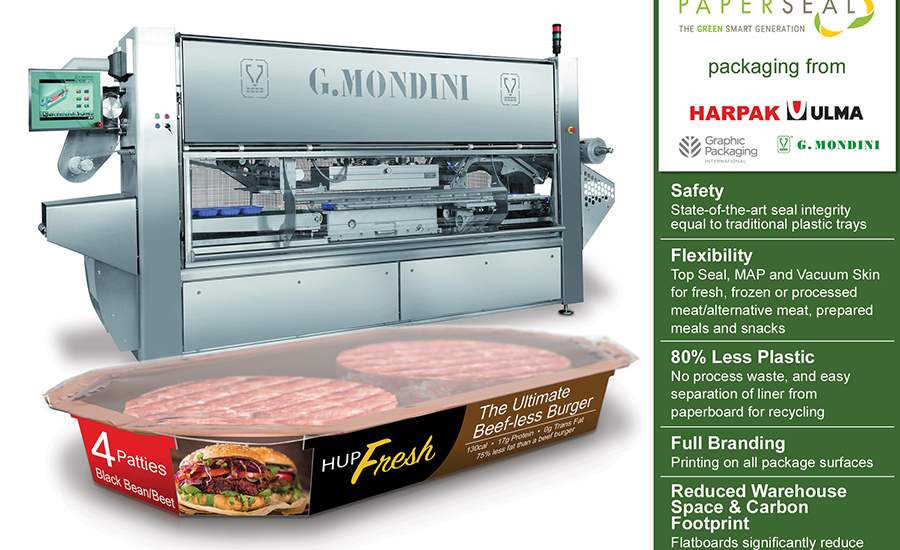 PaperSeal with its partners—Graphic Packaging, Harpak-ULMA and G. Mondini—have come up with a cardboard packaging system with state-of-the-art seal integrity to match that of traditional plastic trays, but uses 80% less plastic. The packaging features top seal, MAP and vacuum skin for fresh, frozen of processed/alternative meat, prepared meals and snacks. Photo courtesy of Harpak-ULMA
PaperSeal with its partners—Graphic Packaging, Harpak-ULMA and G. Mondini—have come up with a cardboard packaging system with state-of-the-art seal integrity to match that of traditional plastic trays, but uses 80% less plastic. The packaging features top seal, MAP and vacuum skin for fresh, frozen of processed/alternative meat, prepared meals and snacks. Photo courtesy of Harpak-ULMA
FE: In general, how is processing/packaging of alternative proteins different from that of conventional proteins?
Siers: In general, while differences in which packaging processes are used by alternative proteins, the processes themselves are not wildly different. However, because alternative protein products are often made from plant-based ingredients, initial processing may involve different types of machinery and equipment than those used in animal-based processing. Specifically, alternative protein products often require specialized processing methods to create the desired texture, flavor and appearance. Plant-based proteins may be sourced from soy, peas, or other plant sources, while cultured proteins require the use of cell culture technology. They may need to be extruded, textured or fermented to achieve the desired texture and flavor, while cultured proteins may require bioreactors and other specialized equipment for cell culture. Extrusion is a common technique used to create plant-based meat analogs, which involves forcing a mixture of ingredients through a small opening to create a meat-like texture.
These products may utilize packaging materials differently than animal-based products. For example, some plant-based meats require oxygen-permeable packaging to maintain their texture and prevent spoilage, while animal-based meats may be packaged in oxygen-impermeable materials to increase shelf life. Cultured proteins may require specialized biodegradable packaging to support the growth and development of the cells.
Because these products are created to resemble conventional proteins, they may require specific pre-packaging treatments to form the product; for example, utilizing a bowl chopper to build body/add substance. These techniques can provide temporary structure, but they do tend to flatten over time. Thus, the requirement is for “more” packaging than conventional proteins to maintain a desirable appearance. Packaging also employs specific labeling and marketing strategies to appeal to consumers, which may involve highlighting the sustainability and ethical production of the product or emphasizing its nutritional benefits.
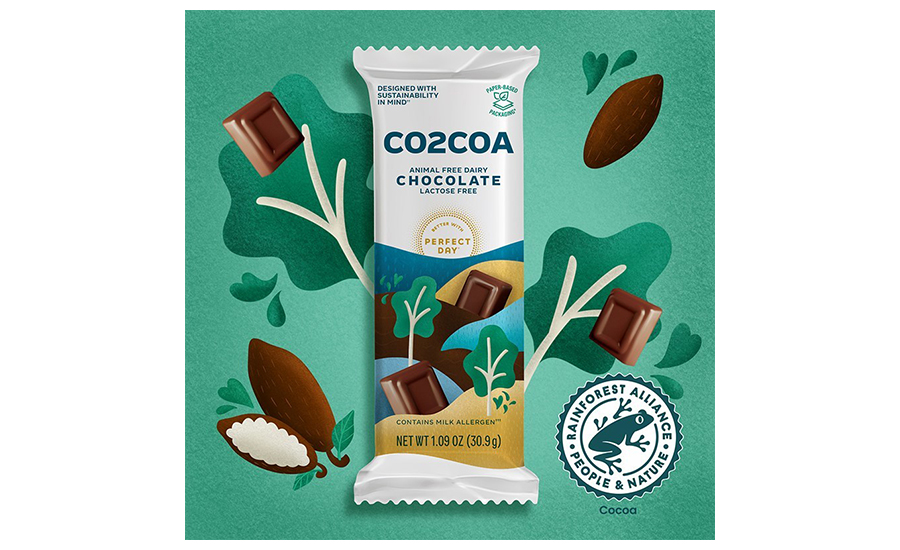 With primary packaging to show its environmental significance, CO2COA by Mars is a sustainability inspired animal-free, planet-friendly chocolate innovation in partnership with Perfect Day. Photo courtesy of Mars
With primary packaging to show its environmental significance, CO2COA by Mars is a sustainability inspired animal-free, planet-friendly chocolate innovation in partnership with Perfect Day. Photo courtesy of Mars
As with any food product, alternative proteins must be processed and packaged in a way that ensures food safety. However, specific safety considerations may differ depending on the type of protein and the processing methods used:
- Packaging alternative proteins requires preventing cross-contamination with other products, especially those containing allergens.
- Alternative proteins are often plant-based and can be highly perishable, requiring temperature-controlled storage and transportation. Packaging should provide sufficient insulation and temperature control to prevent spoilage and bacterial growth.
- Packaging for alternative proteins can require sufficient barrier properties to prevent oxygen, moisture and light from reaching the product to help maintain the product's quality, texture and nutritional value.
- Packaging materials and processes for alternative proteins must comply with relevant regulatory requirements, including those related to food safety, labeling and environmental impact.
- Alternative proteins can be more delicate than meat-based products, and packaging must be designed to protect them during handling and storage. This includes minimizing physical stress, preventing crushing or bruising and ensuring that the packaging is sturdy and resilient.
- Alternative proteins typically have a shorter shelf life than conventional proteins and can spoil more quickly. Packaging should provide clear labeling and expiration dates to help consumers make informed decisions and avoid consuming expired products.
- Consumers are increasingly concerned about the environmental impact of food packaging. Packaging for alternative proteins should be designed with sustainability in mind, using materials that are recyclable or compostable and minimizing waste. For example, the Beyond Meat utilizes fiberboard trays as the product does not exude the same level of liquid as real meat.
FE: What are (if any) the technical differences/considerations in packaging equipment for alternative proteins compared to regular proteins (meats, seafood, etc.)? How do these affect equipment design, construction and setup?
Siers: There are a few technical differences and considerations in packaging equipment for alternative proteins compared to conventional proteins.
- Alternative proteins may have different handling characteristics than conventional proteins. For example, plant-based proteins may be more prone to breakage or may require more careful handling during processing and packaging. They often use different processing methods and have different textures than conventional proteins—which can require different types of packaging equipment. For instance, some plant-based meats may require extrusion-based packaging equipment to create a meat-like texture—but the product itself may lack the cohesive binding characteristics of normal meat. This “product fragility” (vacuum sealing can be too intense) may require specific handling procedures to maintain the desired shape. It is not uncommon for these products to utilize tray sealing techniques or thermoform packaging rather than flow-wrapping for instance.
- Alternative proteins may require different packaging materials than conventional proteins, which can impact the design and construction of packaging equipment. For example, some plant-based proteins may require specialized films or coatings to maintain freshness and prevent oxidation, which may require specialized packaging equipment to apply. For instance, some plant-based meats may require oxygen-permeable packaging to maintain their texture, while other products may require moisture-barrier packaging to prevent dehydration. Sensitivity to oxygen exposure—which affects taste, texture and shelf life—may require packaging processes designed to minimize that exposure.
- Alternative proteins may require different hygiene considerations than conventional proteins, which can impact the design and construction of packaging equipment. For example, some plant-based proteins may be more prone to microbial contamination than conventional meats, which may require specialized equipment with enhanced hygiene features.
- Alternative proteins may be produced at different scales and price points than conventional proteins, which can impact the design and construction of packaging equipment. For example, some plant-based proteins may be produced at a smaller scale than conventional meats, which may require more flexible and cost-effective packaging equipment. Such capacity needs drive packaging line and automation design, facility space requirements, equipment setup and may require specialized machinery and materials:
- Packaging equipment may require specialized design and construction to accommodate the unique product properties and characteristics. For example, equipment may need to be designed to handle the unique textures and shapes of plant-based proteins or to maintain the appropriate temperature and humidity levels for cultured proteins. The equipment may also need to be made of materials that are compatible with the products and packaging materials used to prevent contamination and ensure safety.
- The setup and operation of packaging equipment for alternative proteins may require different processes and procedures than conventional proteins, i.e., different packaging materials or unique processing methods.
- The maintenance of packaging equipment may also be different—requiring more frequent cleaning and maintenance to prevent contamination. Specialized parts and materials may need to be used to ensure the equipment is compatible with the products being packaged.
- Operators of packaging equipment for alternative proteins may require specialized training to handle their unique properties or characteristics. This can include instruction on how to properly handle and package the products, as well as how to properly clean and maintain the equipment to prevent contamination.
- These products typically have greater need for package-based marketing content and labeling. Labeling often utilizes "vegan" or "vegetarian" labeling or even certifications such as organic or non-GMO. Package designs typically allow for more “marketing” content to attract or inform consumers, as well as different product “views” that may be designed to minimize or enhance a specific visual aspect of the product.
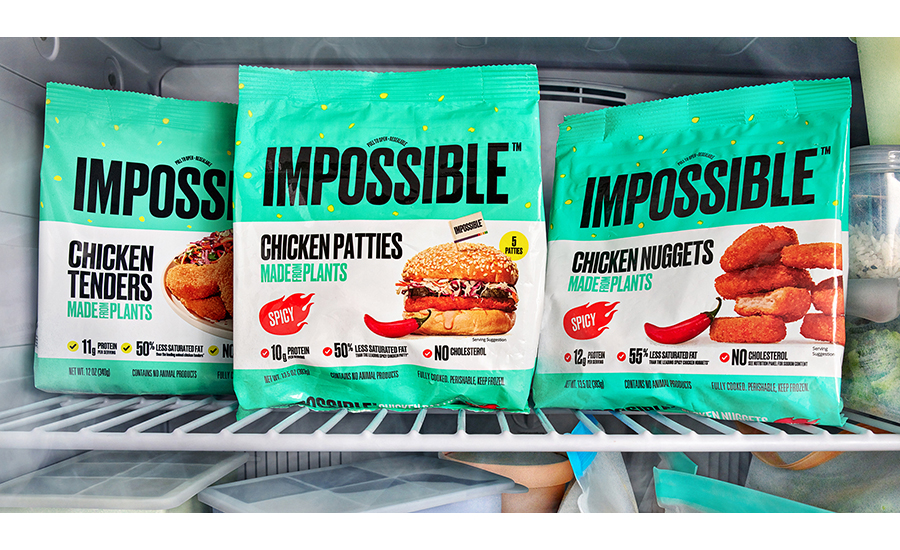 Spicy chicken nuggets, spicy chicken patties and chicken tenders from Impossible Foods unlock new flavors and formats for the brand’s best-selling portfolio of chicken from plants. Photo courtesy of Business Wire
Spicy chicken nuggets, spicy chicken patties and chicken tenders from Impossible Foods unlock new flavors and formats for the brand’s best-selling portfolio of chicken from plants. Photo courtesy of Business Wire
FE: What are (if any) the technical differences/considerations in packaging films/containers for alternative proteins compared to regular proteins (meats, seafood, etc.)? How does this affect packaging designs, graphics, printing?
Siers: Alternative proteins may utilize packaging films/containers with different barrier properties than conventional proteins. For example, some plant-based proteins may require packaging materials that offer better oxygen and moisture barrier properties to maintain freshness and prevent oxidation. Additionally, some alternative proteins may be more sensitive to light, requiring packaging materials that offer better light barrier properties to protect the products.
They often have different shelf-life requirements than conventional proteins, which can impact the design and selection of packaging films/containers. For example, some plant-based proteins may require packaging materials that offer extended shelf life to maintain quality and freshness, whereas some cell-based meats may have a shorter shelf life and may require packaging materials that can be easily recycled or biodegraded. These products require packaging films/containers that offer enhanced product protection during transport and storage. For example, some plant-based proteins may be more fragile and prone to breakage, requiring packaging materials that offer better impact resistance. They may prioritize more sustainable films and/or containers versus conventional proteins—packaging materials that can be easily recycled or biodegraded. Whereas conventional meats may emphasize packaging materials that deliver better protection against contamination.
As already noted above, some plant-based meats require oxygen-permeable packaging to maintain their texture, while other products require moisture-barrier packaging to prevent dehydration, which drives both process and film selection. The choice of packaging films for alternate proteins, versus real meat or cheese for instance, can vary depending on the specific product and its requirements. The following is just a general overview of commonly used packaging films for alternate proteins:
- Polyethylene (PE) film: This is a versatile and widely used packaging film that can be used for various food products, including alternative proteins. PE film is cost effective, has good moisture barrier properties and is easily heat-sealable.
- Polypropylene (PP) film: PP film is a strong and durable packaging film that can be used for packaging alternative proteins. It has good moisture and gas barrier properties and can be easily heat-sealed. PP film is also transparent, which can help showcase the product.
- Sustainable films: Biodegradable films made from renewable resources such as cornstarch or cellulose can be used as an eco-friendly packaging option for alternate proteins. These films can provide good barrier properties and can be heat-sealed like traditional plastic films.
- Vacuum packaging films: Vacuum packaging is a popular packaging method for alternate proteins as it helps extend the shelf life of the product. Vacuum packaging films are specially designed to withstand the vacuum sealing process and can provide good barrier properties to prevent oxygen and moisture from reaching the product.
It's worth noting that the selected packaging materials for any application will differ depending on the type of product, but commonly used materials include various types of plastics, such as PET (polyethylene terephthalate), PVC (polyvinyl chloride), and barrier films such as EVOH (ethylene-vinyl alcohol). Packaging is often designed to showcase the product's appearance and texture, while also emphasizing its sustainability and environmental benefits.
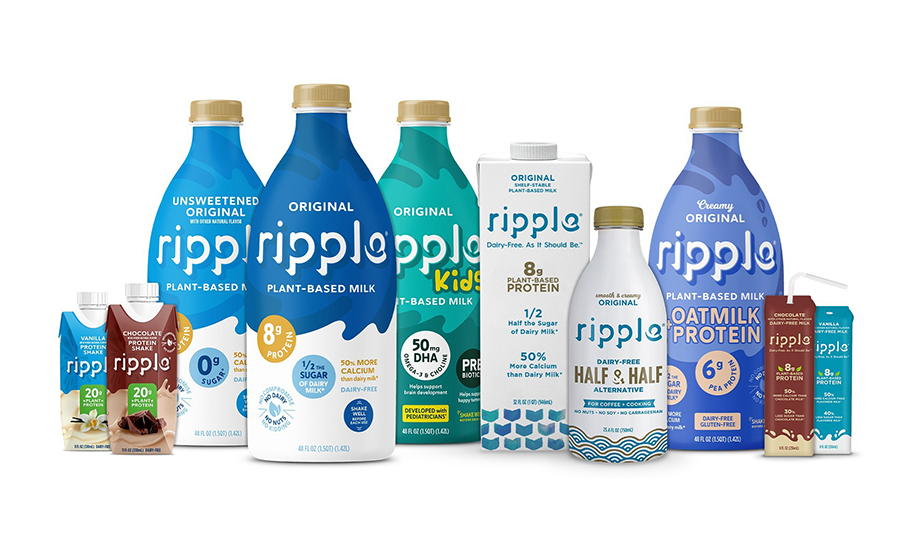 With its unique packaging, Ripple Foods announced the launch of its new 360-campaign Moove Over To Ripple. The campaign educates consumers on the nutrition and taste benefits of its plant-based milk and encourages consumers to make the switch from dairy or alternative milks to Ripple. Photo courtesy of Ripple Foods
With its unique packaging, Ripple Foods announced the launch of its new 360-campaign Moove Over To Ripple. The campaign educates consumers on the nutrition and taste benefits of its plant-based milk and encourages consumers to make the switch from dairy or alternative milks to Ripple. Photo courtesy of Ripple Foods
The technical differences and considerations in packaging films/containers for alternative proteins can impact packaging designs, graphics and printing. For example, the packaging may need to be designed to accommodate the unique shapes and textures of the products, and graphics may need to be developed to highlight the sustainable and eco-friendly nature of the packaging materials. Additionally, the printing process may need to take into account the barrier properties of the packaging materials, as well as the sensitivity of the products to light and oxygen.
Alternative proteins often leverage packaging to help communicate the taste and unique flavor of the product, as well as provide information about its cost and value. Ultimately, alternative protein packaging of products is designed to address and target specific consumer needs and preferences, while still accommodating practical considerations such as cost, convenience and sustainability.
FE: What are the challenges and potential solutions of maintaining alternative protein product quality throughout the processing and packaging stages? How do they differ from conventional proteins?
Siers: Maintaining alternative protein product quality throughout the processing and packaging stages can present different challenges than conventional proteins. Textures, shapes and flavors may be difficult to replicate consistently. Manufacturers may need to carefully control the processing conditions, ingredients and packaging materials used or invest in specialized equipment designed specifically to drive product consistency. Conventional packaging equipment or methods may be modified to better align with the specific product characteristics/needs. For example, product fragility may dictate lower or slower vacuum pressures to avoid product distortion.
Alternative protein products may have different preservation requirements than conventional proteins, which can impact the packaging and processing methods used. For example, some plant-based proteins may require refrigeration or freezing to maintain freshness, while some cell-based meats may have shorter shelf lives and require more careful handling and processing to prevent spoilage. These products often exhibit somewhat different flavor profiles and aromas than conventional proteins, making it challenging to preserve these qualities without vacuum, modified atmosphere or oxygen-permeable/barrier packaging. Sensitivity to oxygen (and temperature) affects taste, texture and shelf life—driving materials and equipment selection that are designed to address such environmental fluctuations.
Products can be susceptible to contamination during processing and packaging, which can impact product safety and quality. To maintain hygiene, manufacturers may need to invest in specialized equipment and packaging materials designed to prevent contamination and ensure that proper cleaning and sanitization procedures are followed throughout the production process. Many of these products are actually sold as “ready to eat” and don’t require cooking—increasing the importance of sanitary practices.
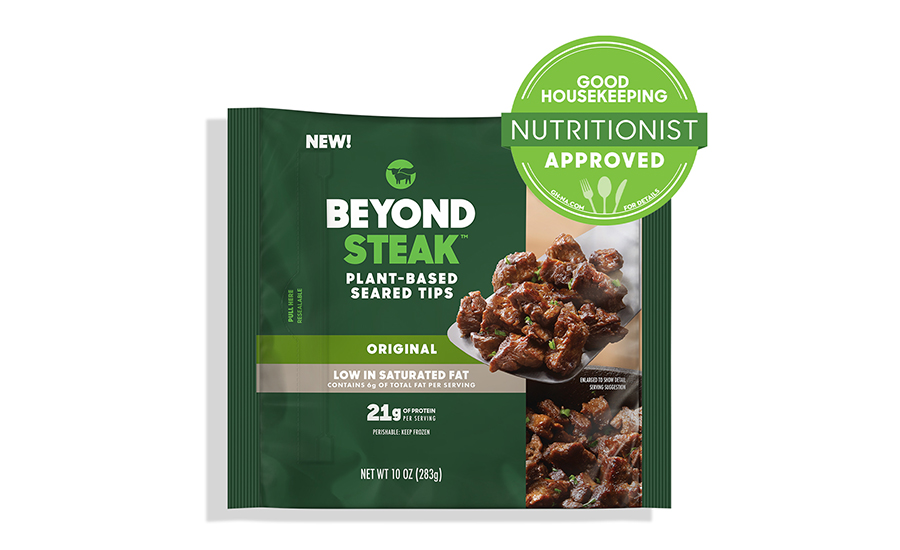 Following a rigorous evaluation by the Good Housekeeping Institute’s Nutrition Lab, Beyond Steak by Beyond Meat received the Good Housekeeping Nutritionist Approved Emblem, making it the first plant-based meat product to receive this honor. Photo courtesy of Beyond Meat
Following a rigorous evaluation by the Good Housekeeping Institute’s Nutrition Lab, Beyond Steak by Beyond Meat received the Good Housekeeping Nutritionist Approved Emblem, making it the first plant-based meat product to receive this honor. Photo courtesy of Beyond Meat
Alternative protein products may be new to some consumers, who may not be familiar with the processing and packaging methods used or the nutritional value of the products. Manufacturers may need to invest in consumer education campaigns to educate consumers on the benefits and proper handling of alternative protein products. Environmentally friendly packaging materials that are easy to recycle or compost can be a consideration.
The challenges of maintaining alternative protein product quality throughout the packaging stages may differ from those of conventional proteins due to the unique characteristics of these products. However, these challenges are addressed through employing standard packaging equipment, while modifying materials and packaging techniques.
Key Supply Chain Issues with Alternative Protein Products
Alternative protein products often require specialized ingredients and materials that may be difficult to source consistently. For one thing, raw material sourcing is quite different. Alternative proteins are often made from plant-based or other non-animal sources, which can be more challenging to source consistently and reliably than animal-based proteins when it comes to processing. Supply chain velocity and reliability for product sourcing will bleed into planning for packaging materials, consumables and perhaps even dictate packaging line flexibility.
Another velocity impact is product shelf life—which is typically shorter than conventional proteins. If a product requires specialized packaging materials or equipment to maintain its shelf life, there may be additional lead times or costs associated with sourcing these materials or equipment. Alternative protein products may have different shipping and handling requirements than conventional proteins, such as temperature-controlled shipping or specialized handling equipment. Specialized storage and transportation conditions may be needed to maintain product quality and shelf life, which can impact the supply chain for packaging materials and equipment. For example, if a product needs to be transported at a specific temperature or humidity level, this may impact the type of packaging materials or equipment that can be used. Packaging considerations may dictate materials designed to withstand shipping and handling stresses while preserving product quality.
Some alternative protein products may be subject to different regulatory requirements than conventional proteins, which can also impact the supply chain for packaging materials and equipment. For example, if a product needs to be labeled in a specific way to meet regulatory requirements, this may determine the type of packaging materials or equipment that must be used (more a supply chain stressor). Overall, supply chain issues can gate access to specialized materials or equipment required to maintain their quality and shelf life. However, as the demand for alternative proteins continues to grow, it is likely that the supply chain for these products will become more established, which may help to alleviate some of these issues over time.
Looking for a reprint of this article?
From high-res PDFs to custom plaques, order your copy today!








